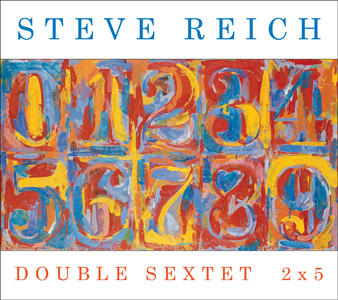Nonesuch releases an album with two Steve Reich compositions—Double Sextet and 2x5—on September 14, 2010. The Pulitzer Prize–winning piece Double Sextet, performed here by eighth blackbird, has been cited "among the finest pieces of our time" by the Philadelphia Inquirer. Bang on a Can perform 2x5, which premiered at the Manchester International Festival on a double bill with Kraftwerk and expands Reich's musical palate with rock instrumentation.
Nonesuch releases an album with two Steve Reich compositions—Double Sextet and 2x5—on September 14, 2010. Double Sextet—which won the Pulitzer Prize in 2009—is performed by eighth blackbird, who commissioned the piece. The Philadelphia Inquirer said of a recent performance by the ensemble, “Double Sextet is…among the finest pieces of our time…more than earlier Reich, it tips from exaltation to menace on a dime.” Bang on a Can perform 2x5, which premiered last summer at a velodrome in Manchester, England. The work shared a double bill with German electronic music pioneers Kraftwerk and was commissioned by MIF in association with Casa da Música (Porto).
Double Sextet comprises two identical sextets of flute, clarinet, vibraphone, piano, violin, and cello. Doubling the instrumentation was done so that, as in so many of Reich’s earlier works, two identical instruments could interlock to produce one overall pattern. The composer says, “For example, in this piece you will hear the pianos and vibes interlocking in a highly rhythmic way to drive the rest of the ensemble.” The piece can be played in two ways: with 12 musicians, or with six playing against a recording of themselves.
Reich continues, “The idea of a single player playing against a recording of themselves goes all the way back to Violin Phase of 1967. The expansion of this idea to an entire chamber ensemble playing against pre-recordings of itself begins with Different Trains (1988). By doubling an entire chamber ensemble, one creates the possibility for multiple simultaneous contrapuntal webs of identical instruments.”
In 2x5, Reich expands his palate with rock instrumentation. Scored for two sets of five instruments (hence “2x5”), this 21-minute piece calls for a total of ten musicians: four electric guitars, two pianos, two bass guitars, and two drum sets. Performers can either play the piece all-live with ten musicians or with five live musicians against a pre-recorded tape, as Bang on a Can did for the premiere on the opening night of the Manchester International Festival.
“Clearly 2x5 is not rock and roll, but uses the same instruments. It’s an example of the essential difference between ‘classical music’ and ‘popular music.’ And that essential difference is: one is notated, and the other is not notated,” Reich says. “I had to find musicians who (A), could read, and (B), had a genuine rock feeling, and there Bang on a Can excels.”
For more information, visit nonesuch.com/albums/double-sextet.
- Log in to post comments



